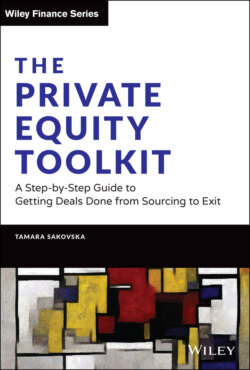Читать книгу The Private Equity Toolkit - Tamara Sakovska - Страница 49
7. Set-up a dedicated digital platform to manage your deal origination workflows
ОглавлениеWe are fortunate to live during times of easy access to technology. When I started my career in finance, my colleagues and I thought our internal processes were quite high-tech: any paper documents were scanned immediately and virtually all of our workflows were backed up electronically. However, we operated a number of completely autonomous systems consisting of numerous spreadsheets, email messages, calendar entries and contact databases. While each team member was handling vast amounts of data, there was no easy way to connect various knowledge silos in order to inform our firmwide strategy. Integrating data was time-consuming and required cumbersome manual effort. These work processes were not considered unusual at the time, with most other funds facing the same challenges.
Luckily, legacy systems are being gradually replaced by powerful digital platforms that connect information from various sources quickly and seamlessly. Your fund is most likely already employing an integrated technology-enabled solution that allows you to optimize your workflows and access crucial information quickly. If this is not the case, you might want to raise this issue at your organization as a matter of priority: digital platforms provide significant operational efficiency and require relatively little human or financial capital. Learn to use and understand in detail the functionality of the technology platform that your firm has so that you can manage all your deal origination workflows digitally in order to enhance your productivity. What goals should you seek to accomplish? In my experience I have found several areas where digital tools can provide a competitive advantage:
Deal pipeline analytics. Capturing historical and current deal flow allows you to analyze transactions by deal origination source, calculate conversion ratios and benchmark the number of deals you see against transactions done in the broader market over a period of time. You can also garner strategic insights from analyzing what areas of your activity create the most value over time. How many companies did you screen and how many deals were selected for further due diligence? How many deals got executed and closed? What were the common traits of successful transactions? Who are the intermediaries who consistently make a positive contribution to your deal origination process?
Transaction tracking. Once you begin developing a deal lead or work on a live transaction, it is helpful to have one easily accessible place that keeps track of the current deal status and next steps. All your electronic notes can be tagged appropriately to make them searchable. You may decide to add any relevant documents, emails, meeting notes and latest updates on the transaction to ensure that your entire deal team has access to the same up-to-date information.
Relationship management. This is a good place to keep your network of contacts and track your conversations, emails and meeting notes with them. You can leverage your relationships better if you log a history of your most valuable contacts, from how you met to their current industry position and previous roles. Record their contributions to your firm and set up future reminders alerting you to follow up with them at an appropriate time to keep your network active.
Knowledge repository. This is very much an optional feature. To the extent your fund does not operate a firmwide information hub where teams can exchange insights or share industry reports, it might be appropriate to create a dedicated place for this kind of activity to live on the same platform. Integrating various knowledge silos across the entire organization, or at least across your team, provides you with a distinctive information advantage that will help you stand out from your competition.
